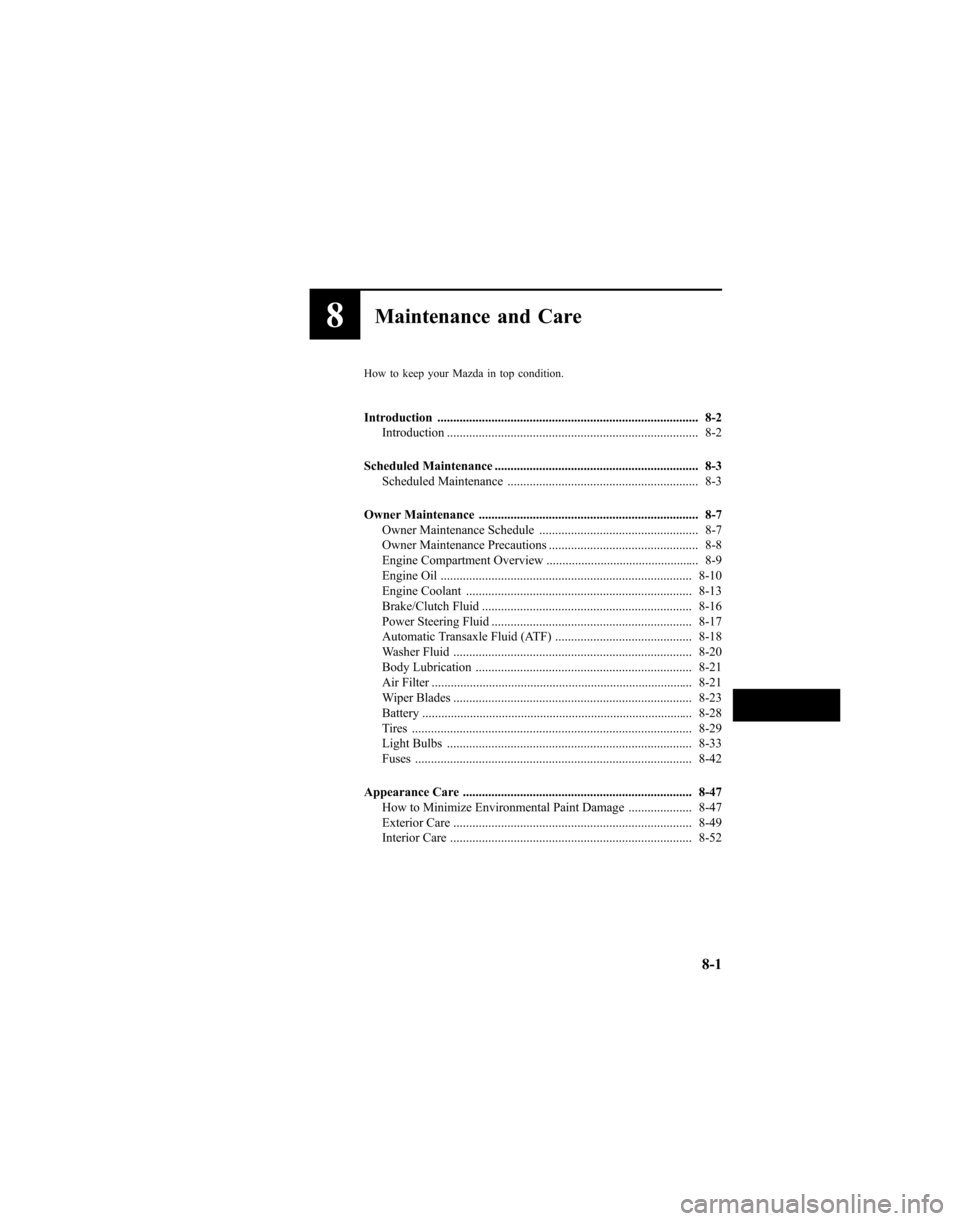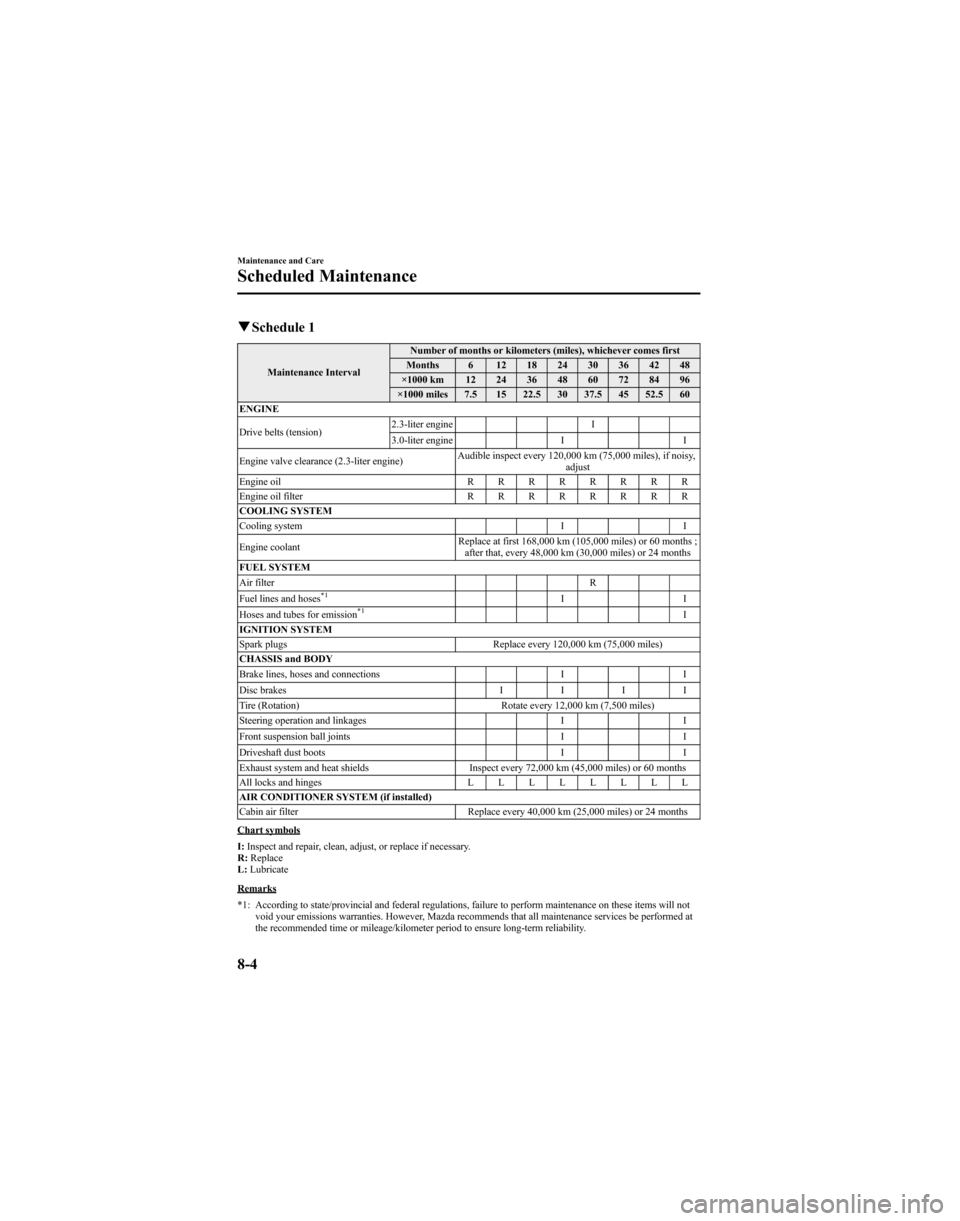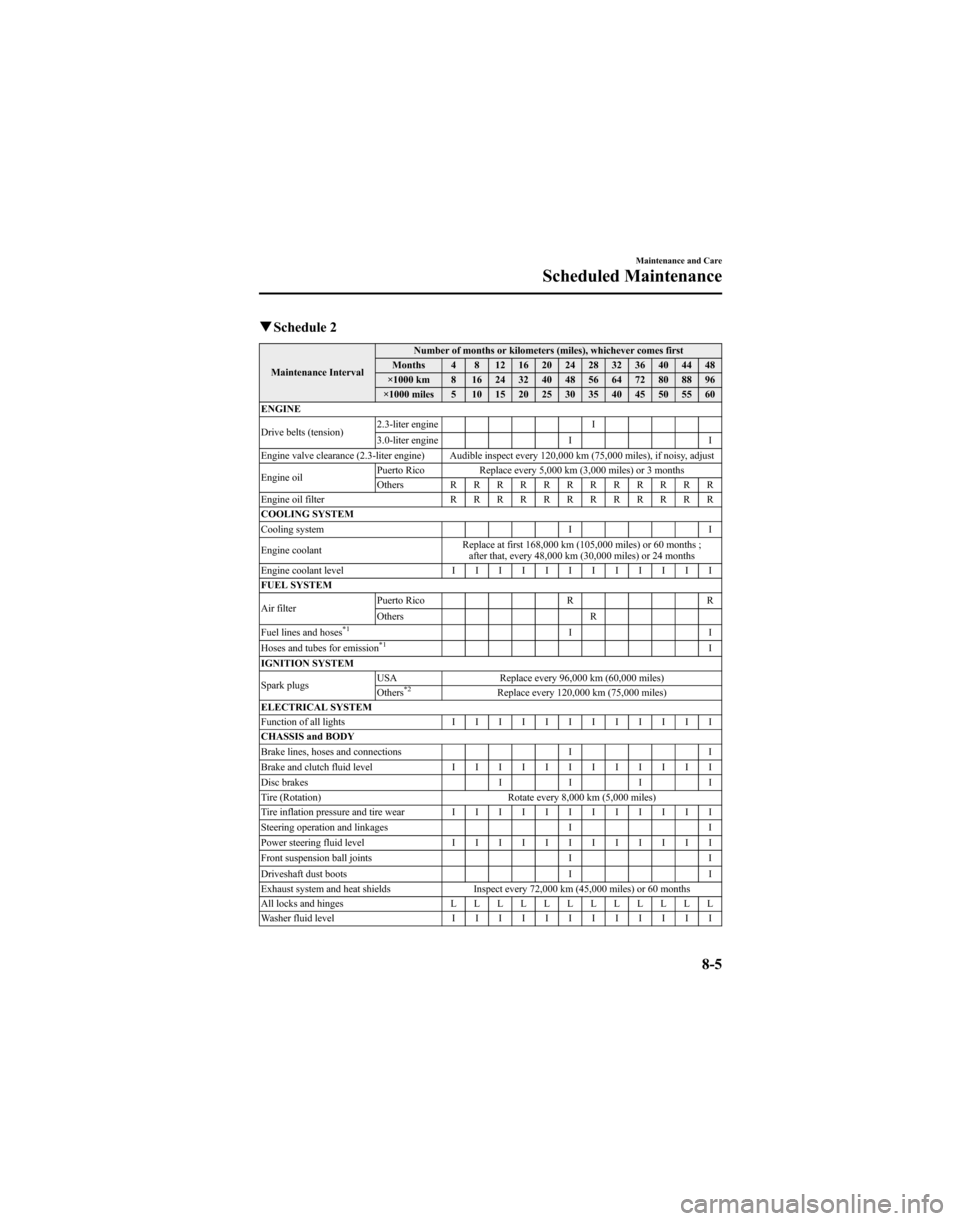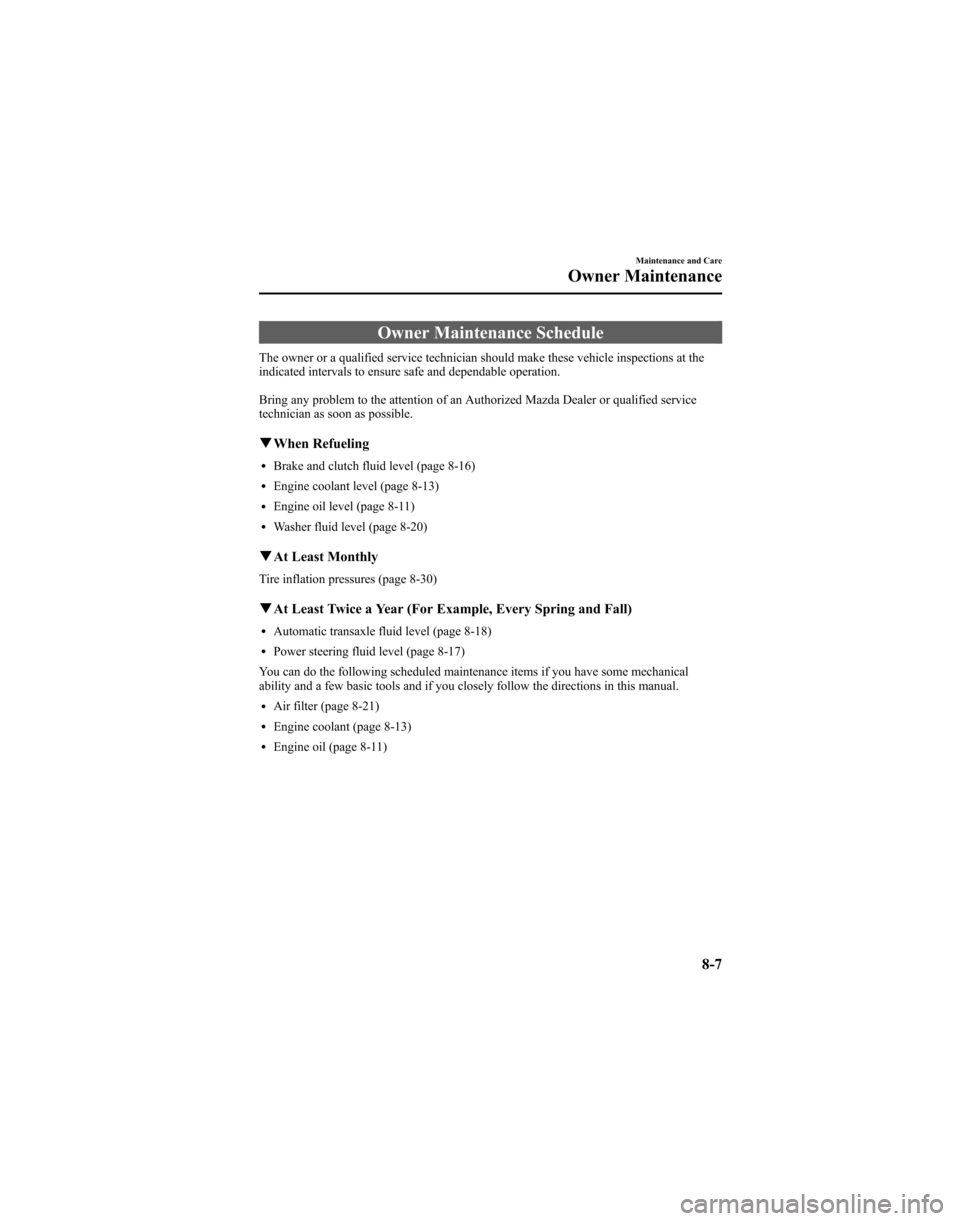steering MAZDA MODEL 6 HATCHBACK 2005 (in English) Owner's Manual
[x] Cancel search | Manufacturer: MAZDA, Model Year: 2005, Model line: MODEL 6 HATCHBACK, Model: MAZDA MODEL 6 HATCHBACK 2005Pages: 340, PDF Size: 3.08 MB
Page 173 of 340

6Interior Comfort
Use of various features for drive comfort, including air-conditioning and audio
system.
Climate Control System ............................................................... 6-2Operating Tips ........................................................................... 6-2
Vent Operation .......................................................................... 6-3
Types of the Climate Control System ....................................... 6-5
Manual Type ............................................................................. 6-6
Fully Automatic Type ............................................................. 6-11
Audio System ............................................................................... 6-16 Antenna ................................................................................... 6-16
Operating Tips for Audio System ........................................... 6-16
Audio Set ................................................................................ 6-23
Audio Control Switch Operation (Steering Wheel)
í............. 6-40
Safety Certification ................................................................. 6-42
Interior Equipment ..................................................................... 6-43 Sunvisors ................................................................................. 6-43
Interior Lights ......................................................................... 6-43
Information Display ................................................................ 6-46
Lighter ..................................................................................... 6-48
Ashtray .................................................................................... 6-49
Cup Holder .............................................................................. 6-50
Bottle Holder ........................................................................... 6-51
Storage Compartments ............................................................ 6-51
Accessory Socket .................................................................... 6-55
6-1íSome models.
Page 212 of 340

Audio Control Switch
Operation (Steering
Wheel)
í
NOTE
Mazda installed this system to help you
avoid being too distracted using audio
controls on the dashboard. Always
make safe driving your first priority.
qAdjusting the Volume
To increase the volume, press volume
button ().
To decrease the volume, press volume
button (
).
q Changing the Source
Press the mode switch () to change
the audio source (FM1 radio> FM2 radio>
AM radio> CD player or CD changer>
Cassette tape player or MD player>
SIRIUS1> SIRIUS2> SIRIUS3>
cyclical).
NOTE
Cassette tape, MD, CD, CD changer
and SIRIUS digital satellite radio
modes cannot be selected in the
following cases:
lA cassette deck, MD, CD, CD
changer, or SIRIUS digital satellite
radio unit is not equipped on the
audio system.
lA cassette tape, MD or CD has not
been inserted.
6-40
Interior Comfort
íSome models.
Audio System
Page 236 of 340

Changing a Flat Tire
NOTE
If the following occurs while driving, it
could indicate a flat tire.
lSteering becomes difficult.
lThe vehicle begins to vibrate
excessively.
lThe vehicle pulls in one direction.
If you have a flat tire, drive slowly to a
level spot that is well off the road and out
of the way of traffic to change the tire.
Stopping in traffic or on the shoulder of a
busy road is dangerous.
WARNING
Jacking a Vehicle:
Changing a tire is dangerous if not
done properly. The vehicle can slip off
the jack and seriously injure someone.
Be sure to follow the directions for
changing a tire, and never get under a
vehicle that is supported only by a
jack.
Passenger in Vehicle Supported by aJack:
Allowing someone to remain in a
vehicle supported by a jack is
dangerous. The occupant could cause
the vehicle to fall resulting in serious
injury. Never allow anyone inside a
vehicle supported by a jack.
NOTE
Make sure the jack is well lubricated
before using it. 1. Park on a level surface off the right-of-
way and firmly set the parking brake.
2. Put a vehicle with an automatic transaxle in Park (P), a manual
transaxle in Reverse (R) or 1, and turn
off the engine.
3. Turn on the hazard warning flasher.
4. Have everyone get out of the vehicle and away from the vehicle and traffic.
5. Remove the jack, tool, and spare tire (page 7-3).
6. Block the wheel diagonally opposite the flat tire. When blocking a wheel,
place a block both in front and behind
the tire.
NOTE
When blocking a tire, use rocks or
wood blocks of sufficient size to hold
the tire in place.
7-8
In Case of an Emergency
Flat Tire
Page 251 of 340

8Maintenance and Care
How to keep your Mazda in top condition.
Introduction .................................................................................. 8-2Introduction ............................................................................... 8-2
Scheduled Maintenance ................................................................ 8-3 Scheduled Maintenance ............................................................ 8-3
Owner Maintenance ..................................................................... 8-7 Owner Maintenance Schedule .................................................. 8-7
Owner Maintenance Precautions ............................................... 8-8
Engine Compartment Overview ................................................ 8-9
Engine Oil ............................................................................... 8-10
Engine Coolant ....................................................................... 8-13
Brake/Clutch Fluid .................................................................. 8-16
Power Steering Fluid ............................................................... 8-17
Automatic Transaxle Fluid (ATF) ........................................... 8-18
Washer Fluid ........................................................................... 8-20
Body Lubrication .................................................................... 8-21
Air Filter .................................................................................. 8-21
Wiper Blades ........................................................................... 8-23
Battery ..................................................................................... 8-28
Tires ........................................................................................ 8-29
Light Bulbs ............................................................................. 8-33
Fuses ....................................................................................... 8-42
Appearance Care ........................................................................ 8-47 How to Minimize Environmental Paint Damage .................... 8-47
Exterior Care ........................................................................... 8-49
Interior Care ............................................................................ 8-52
8-1
Page 254 of 340

qSchedule 1
Maintenance Interval Number of months or kilometers (miles), whichever comes first
Months 6 12 18 24 30 36 42 48
×1000 km 12 24 36 48 60 72 84 96
×1000 miles 7.5 15 22.5 30 37.5 45 52.5 60
ENGINE
Drive belts (tension) 2.3-liter engine I
3.0-liter engine I I
Engine valve clearance (2.3-liter engine) Audible inspect every 120,000 km (75,000 miles), if noisy,
adjust
Engine oil R R R R R R R R
Engine oil filter R R R R R R R R
COOLING SYSTEM
Cooling system I I
Engine coolant Replace at first 168,000 km (105,000 miles) or 60 months ;
after that, every 48,000 km (30,000 miles) or 24 months
FUEL SYSTEM
Air filter R
Fuel lines and hoses
*1II
Hoses and tubes for emission*1I
IGNITION SYSTEM
Spark plugs Replace every 120,000 km (75,000 miles)
CHASSIS and BODY
Brake lines, hoses and connections I I
Disc brakes I I I I
Tire (Rotation) Rotate every 12,000 km (7,500 miles)
Steering operation and linkages I I
Front suspension ball joints I I
Driveshaft dust boots I I
Exhaust system and heat shields Inspect every 72,000 km (45,000 miles) or 60 months
All locks and hinges L L L L L L L L
AIR CONDITIONER SYSTEM (if installed)
Cabin air filter Replace every 40,000 km (25,000 miles) or 24 months
Chart symbols
I: Inspect and repair, clean, adjust, or replace if necessary.
R: Replace
L: Lubricate
Remarks
*1: According to state/provincial and federal regulations, failure to perform maintenance on these items will not
void your emissions warranties. However, Mazda recommends that all maintenance services be performed at
the recommended time or mileage/kilometer period to ensure long-term reliability.
8-4
Maintenance and Care
Scheduled Maintenance
Page 255 of 340

qSchedule 2
Maintenance Interval Number of months or kilometers (miles), whichever comes first
Months 4 8 12 16 20 24 28 32 36 40 44 48
×1000 km 8 16 24 32 40 48 56 64 72 80 88 96
×1000 miles 5 10 15 20 25 30 35 40 45 50 55 60
ENGINE
Drive belts (tension) 2.3-liter engine I
3.0-liter engine I I
Engine valve clearance (2.3-liter engine) Audible inspect every 120,000 km (75,000 miles), if noisy, adjust
Engine oil Puerto Rico Replace every 5,000 km (3,000 miles) or 3 months
Others R R R R R R R
RRRRR
Engine oil filter R R R R R R R RRRRR
COOLING SYSTEM
Cooling system I I
Engine coolant Replace at first 168,000 km (105,000 miles) or 60 months ;
after that, every 48,000 km (30,000 miles) or 24 months
Engine coolant level I I I I I I I IIIII
FUEL SYSTEM
Air filter Puerto Rico R R
Others R
Fuel lines and hoses
*1II
Hoses and tubes for emission*1I
IGNITION SYSTEM
Spark plugs USA Replace every 96,000 km (60,000 miles)
Others
*2Replace every 120,000 km (75,000 miles)
ELECTRICAL SYSTEM
Function of all lights I I I I I I I IIIII
CHASSIS and BODY
Brake lines, hoses and connections I I
Brake and clutch fluid level I I I I I I I IIIII
Disc brakes IIII
Tire (Rotation) Rotate every 8,000 km (5,000 miles)
Tire inflation pressure and tire wear I I I I I I I IIIII
Steering operation and linkages I I
Power steering fluid level I I I I I I I IIIII
Front suspension ball joints I I
Driveshaft dust boots I I
Exhaust system and heat shields Inspect every 72,000 km (45,000 miles) or 60 months
All locks and hinges L L L L L L LLLLLL
Washer fluid level I I I I I I I IIIII
Maintenance and Care
Scheduled Maintenance
8-5
Page 257 of 340

Owner Maintenance Schedule
The owner or a qualified service technician should make these vehicle inspections at the
indicated intervals to ensure safe and dependable operation.
Bring any problem to the attention of an Authorized Mazda Dealer or qualified service
technician as soon as possible.
qWhen Refueling
lBrake and clutch fluid level (page 8-16)
lEngine coolant level (page 8-13)
lEngine oil level (page 8-11)
lWasher fluid level (page 8-20)
qAt Least Monthly
Tire inflation pressures (page 8-30)
qAt Least Twice a Year (For Example, Every Spring and Fall)
lAutomatic transaxle fluid level (page 8-18)
lPower steering fluid level (page 8-17)
You can do the following scheduled maintenance items if you have some mechanical
ability and a few basic tools and if you closely follow the directions in this manual.
lAir filter (page 8-21)
lEngine coolant (page 8-13)
lEngine oil (page 8-11)
Maintenance and Care
Owner Maintenance
8-7
Page 259 of 340

Engine Compartment Overview
Power steering
fluid reservoirWindshield washer
fluid reservoir
Fuse block
Air filter
Brake/Clutch fluid reservoir
Engine coolant
reservoir
Engine coolant
reservoir Automatic transaxle fluid-level dipstick
(only for automatic transaxle) Automatic transaxle fluid-level dipstick
(only for automatic transaxle)
2.3-liter engine
3.0-liter engine Battery
Engine oil dipstick
Windshield washer
fluid reservoir Power steering
fluid reservoir
Cooling system cap Engine oil-filler cap
Brake/Clutch fluid reservoir
Air filter Fuse blockBattery
Engine oil-filler cap
Engine oil dipstick Cooling system cap
Maintenance and Care
Owner Maintenance
8-9
Page 267 of 340

qAdding Brake/Clutch Fluid
WARNING
Spilled Brake Fluid:
Spilled brake fluid is dangerous. If it
gets in your eyes, they could be
seriously injured. If this happens,
immediately flush your eyes with water
and get medical attention. Brake fluid
spilled on a hot engine could cause a
fire. Be careful not to spill brake fluid
on yourself or on the engine.
Low Brake/Clutch Fluid Levels:
Low brake/clutch fluid levels are
dangerous. Low levels could signal
brake lining wear or a brake system
leak. Your brakes could fail and cause
an accident. If you find a low fluid
level, have the brakes and clutch
inspected.
If the fluid level is low, add fluid until it
reaches MAX.
Before adding fluid, thoroughly clean the
area around the cap.
CAUTION
lBrake and clutch fluid will damage
painted surfaces. If brake or clutch
fluid does get on a painted surface,
wipe it off immediately.
lUsing nonspecified brake and clutch
fluids (page 10-4) will damage the
systems. Mixing different fluids will
also damage them.
If the brake/clutch system frequently
requires new fluid, consult an
Authorized Mazda Dealer.
Power Steering Fluid
q Inspecting Power Steering Fluid
Level
CAUTION
To avoid damage to the power steering
pump, don't operate the vehicle for long
periods when the power steering fluid
level is low.
NOTE
Use specified power steering fluid
(page 10-4).
2.3-liter engine
Inspect the fluid level in the reservoir at
each engine oil change with the engine off
and cold. Add fluid if necessary; it does
not require periodic changing.
The level must be kept between MIN and
MAX.
Visually examine the lines and hoses for
leaks and damage.
Maintenance and Care
Owner Maintenance
8-17
Page 281 of 340

Also, inspect them for uneven wear and
damage. Abnormal wear is usually caused
by one or a combination of the following:
lIncorrect tire pressure
lImproper wheel alignment
lOut-of-balance wheel
lSevere braking
After rotation, inflate all tire pressures to
specification (page 10-7) and inspect the
lug nuts for tightness.
CAUTION
Rotate unidirectional tires and radial
tires that have an asymmetrical tread
pattern or studs only from front to rear,
not from side to side. Tire performance
will be weakened if rotated from side to
side.
q Replacing a Tire
WARNING
Worn Tires:
Driving with worn tires is dangerous.
Reduced braking, steering, and
traction could result in an accident.
Always use tires that are in good
condition. If a tire wears evenly, a wear indicator
will appear as a solid band across the
tread.
Replace the tire when this happens.
New tread
Tread wear indicator
Worn tread
You should replace it before the band is
across the entire tread.
qTemporary Spare Tire
Inspect the temporary spare tire at least
monthly to make sure it's properly inflated
and stored.
The temporary spare tire is easier to
handle because of its construction. It is
lighter and smaller than a conventional
tire and should be used only for an
emergency and only for a short distance.
Use the temporary only until the
conventional tire is repaired, which should
be as soon as possible.
Maintain its pressure at 420 kPa (4.2 kgf/
cm
2or bar, 60 psi).
Maintenance and Care
Owner Maintenance
8-31